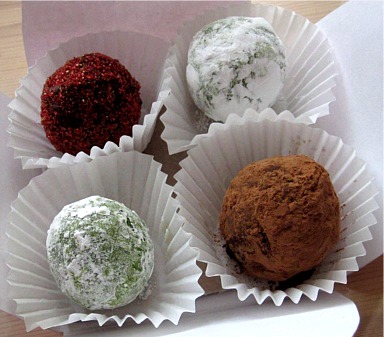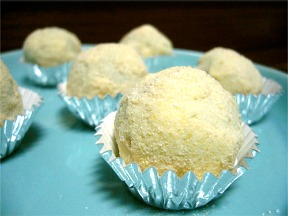
Photo and truffles by kake, Premium Member © Sarah Phillips

Photo and truffles by Orange Piggy, Premium Member © Sarah Phillips
Ganache is an emulsion of chocolate and and some form of liquid, being cream, water, butter or a combination of liquids.
There are two ways to make a ganache emulsion; one, is to chop the chocolate, heat cream until it boils, and pour it over the chopped chocolate and stir until the chocolate melts and emulsifies. The other way is to melt the chocolate in the top of a double boiler, and add the cream that has been heated until it boils. Then stir until it forms a nice shiny mixture. You can use either technique with this recipe.
This recipe can be made with either semisweet (62%) or bittersweet (70%) chocolate. Use the ganache for either truffle centers or as an icing. The proportion of chocolate to cream will determine the sweetness of the ganache, the intensity of the chocolate flavor, as well as how thin or thick the ganache will be.
CHOCOLATE RECIPE HELP
INGREDIENTS
Truffles
1/2 cup heavy whipping cream
2 tablespoons (1/4 stick) unsalted butter, room temperature
1 tablespoon light corn syrup, glucose or Tate and Lyle's Golden Syrup; SARAH SAYS: Orange Piggy used Maple Syrup, which is a fab idea!
9 ounces bittersweet or semisweet chocolate, melted
1 tablespoon cognac or other fine brandy
1 tablespoon dark rum
Enrobing
12 to 16-ounces bittersweet or semisweet chocolate, preferably tempered; You can also use a Compound Coating (Candy Melts) which does not need tempering.
Coating
2 cups alkalized (Dutch process) cocoa or praline powder or powdered sugar, sifted through a fine mesh strainer; measure and then sift a couple of times.
SARAH SAYS: Orange Piggy used some very interesting coverings, such as green tea or white malt powder. You can also use finely chopped nuts, lightly toasted coconut or crushed candy.
2 cookie sheets or jelly-roll pans lined with parchment paper.
INSTRUCTIONS
1. Using a heavy serrated knife, finely chop the chocolate into 1/4-inch pieces. SARAH SAYS: You want evenly sized pieces so all of the chocolate melts at the same time. Place the chocolate in a heat proof bowl.
2. Combine cream, butter and corn syrup in a heavy bottomed, nonreactive pan. Bring to a boil over low heat while stirring constantly. Boiling means the cream will actually rise up in the pan and threaten to boil over. Make sure there is still steam rising from the pot. While the cream boils, it measures 212 degrees F.
3. Let the cream mixture cool. When the temperature of the cream has decreased to about 110 F, measured with an Instant Read Thermometer – insert tip in the middle of the hot cream after stirring – begin slowly pouring the cream (its temperature will have decreased, but if it goes below 90 degrees F, briefly reheat it) into the chopped chocolate.
Tap the bowl on the counter to settle the chocolate into the cream mixture, making certain that the chocolate is thoroughly dispersed throughout the cream. Then, let it sit for 1 minute. Using a rubber spatula, slowly stir in a circular motion, starting from the center of the bowl and working out to the sides. Be careful not to add too much air to the ganache. Stir until all the chocolate is melted, about 2 minutes. It may look done after 1 minute of stirring, but keep going to be sure it's emulsified.
Immediately, stir in room temperature cognac and rum.
SARAH SAYS: To emulsify the chocolate and cream, the cream is first heated which reduces its water content. The hot cream is poured over the chocolate and it melts after sitting for a few minutes. They are slowly mixed together. The waiting time also serves to bring down its temperature down because emulsions form better at 90 degrees to 110 degrees F. The emulsification takes place by the combination of work or stirring, which breaks down the fat in both the cream and chocolate into microscopic droplets, small enough to be suspended within the water – and the use of an emulsifier to stabilize the system, or fatty acids present in the cream.
4. Pour into a 9 x 9-inch heatproof glass pan. Cover loosely with plastic wrap and let center mixture crystallize for 24 hours at room temperature, 36 hours if using milk or white chocolate ganache. The best consistency for use in truffles is that of thick peanut butter or slightly stiffer.
WHIP GANACHE
You can optionally whip the ganache to form the truffle centers. When ganache mixture has reached 90 degrees, use an electric mixer on medium speed to whip the room temperature mixture for about a minute, until it lightens in color. Beating ganache causes its shelf life will be decreased because you are introducing air into the mixture.
FORM GANACHE BALLS
With a teaspoon or a melon baller, scoop out one teaspoon (or larger) of ganache and quickly roll into a ball between your palms. The small balls do not have to be uniform; they can be slightly irregular in shape. Place on a cookie sheet lined with parchment paper or a sheet of aluminum foil. Optionally, let sit another 24 hours or 36 hours if working with milk or white chocolate, if enrobing in chocolate.
WAYS TO FINISH TRUFFLES
1. ENROBE TRUFFLES IN CHOCOLATE
A. You can optionally coat the truffle centers in tempered 12- to 16-ounces chocolate. You can also use a Compound Coating which does not need tempering.
SARAH SAYS: The best way to enrobe ganache centers, is to wait after forming into balls, until they have firmed for at least 24-hours before enrobing or 36 hours if working with milk or white chocolate. But, it is optional.
How Ganache Centers are Enrobed: Put ganache centers on dipping fork (pronged or with a loop at the end). Lower into tempered chocolate. Lift out, tap the bottom of the fork on the side of the bowl and hold over bowl to drain off excess. Drop onto parchment paper lined rimmed cookie sheet because the truffles can roll around. If your work room is warm, let the enrobed truffles set in the refrigerator for
If you don't have dipping forks then use two plastic forks with the two center tines removed.
Another way is to smear some chocolate on a gloved hand (use the thin white gloves available from the grocery store). Gently rub each chilled truffle center to coat lightly with chocolate.
B. Optionally, cover enrobed truffles with cocoa powder, etc: Right after enrobing, immediately toss truffles in cocoa or powdered sugar until thoroughly covered. Roll finished truffles in a strainer over a piece of wax paper to remove excess cocoa. Lift truffles from strainer so excess cocoa remains behind. (Sift cocoa through a fine strainer to remove any bits of chocolate and it may be reused.)
2. OTHER WAYS TO FINISH COATED GANACHE CENTERS
After forming the truffle centers, drop directly into a bowl of sifted cocoa powder or other dry coverings. Roll the center with a fork so it is covered all over. Don't handle truffle with fingertips because they are warm and may melt the chocolate covering or dissolve the ingredients that are dusted on the outside. After dusting, place a few at a time in a large fine mesh strainer, and gently tap out excess coverings and drop onto a rimmed parchment-lined cookie sheet.
STORAGE
A classic ganache can generally stay at room temperature for 2 days, as long as it's kept in a cool place. Then it must be refrigerated.
Truffles can be frozen in an airtight container for a month or more.
If in a bowl, always place a piece of plastic wrap firmly against its surface so a film does not form or it won't form a sugar crust on its surface. Ganache can be frozen for a month. Reheat in the top of a double boiler under gentle heat, whisking together in one direction, before using.


